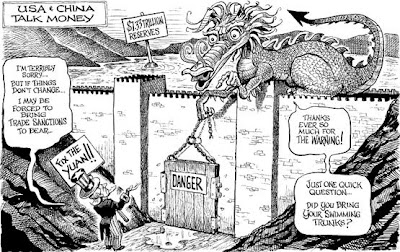This experience emboldened me to follow up by shooting him an email. In this email I asked Ben Bernanke--who was also the AER editor at the time--why there was not more research being done on productivity-driven deflation, given that it seemed a reasonable way to interpet the low inflation of 2003. To my surprise, Ben actually replied with a most interesting response. First, he said there was some work being done on this issue and pointed me toward Michael Bordo and Angela Redish's deflation paper. Then--and this was the shocker to me--he proceeded to justify the extreme lowering of the Federal Funds rate by noting the low capacity utilization rate and how it supercedded any productivity-driven deflation considerations. In other words, he acknowledged the possibility that benign deflationary pressures could be at work, but fell back on the low capacity utilization interpretation of the low inflation in 2003. Ben Bernanke believed most, if not all, of the low inflation of this time was due to a weakening of aggregate demand not a strengthening of aggregate supply. In his 2003 speech, "An Unwelcome Fall in Inflation?" he makes the same connection between low capacity utilization and low inflation:
"Although (according to the National Bureau of Economic Research) the U.S. economy is technically in a recovery, job losses have remained significant this year, and capacity utilization in the industrial sector (the only sector for which estimates are available) is still low, suggesting that resource utilization for the economy as a whole is well below normal... [this] persistent slack might result in continuing disinflation..."
There are, however, theoretical reason why capacity utilization may not be closely tied to inflation and there is empirical evidence showing this metric to be a poor forecaster of inflation. On the first point, some argue that globalization has made domestic capacity constraints less meaningful. Other observers note that the link between capacity utilization and inflation is premised on demand being the main driver of inflationary pressures, when in fact supply shocks can also be important. I find this second argument the most compelling because it was during this very time (2002-2004) that produtivity growth was increasing (see my productivity graph). One the second point, I direct you to a Dallas Fed study showing the capacity utilization and inflation relationship breaksdown after 1983. Also check out the Stephen Cecchetti and friends study that shows capacity utlization to be one of the worse inflation predictors. In fact, this study shows that capacity utilization relative to an autoregrssion actually reduces the accruacy of forecasting inflation.
Why am I sharing all of this with you? Because it is germaine to question of whether the deflation scare of 2oo3 was mishandled by the Federal Reserve. Now Ben Bernanke was only a governor at the time, but his view is probably a good representation of what the Fed was thinking: low inflation => low aggregate demand => low interest rates needed. As I have stated elsewhere on this blog, what they should have been thinking is low inflation low inflation => robust productivity growth => no need to cut rates (maybe even raise them).
Update
I went ahead and did some preliminary analysis of my own on the relationship among inflation, capacity utilization, and productivity. Specifically, I ran a distributed-lag regression with the q/q CPI inflation rate as the dependent variable and regressed on it the industrial capacity utilization rate and the q/q non-farm business sector productivity growth rate for the years 1967:Q1 -2007:Q2 (all data is from the FRED database). The regression included 8 lags plus the contemporaneous value of each right-hand side variable in the regre
 ssion. The distributed-lag regression was run such that dynamic cumulative multipliers were estimated. Next, I applied one standard deviation of each right hand side variable to its cumulative multipliers and come up with the graph to the right. Here, the cumulative response of inflation over time to both series receiving a a one-standard deviation shock is portrayed. Confidence bands of 95% are marked by the dashed lines. Note that the effect of a productivity shock is far larger than the capacity utilization shock. The productivity shock causes a permanent decline in inflation of about 0.9%, while the capacity shock effect is teetering around a 0.1% increase. Moreover, the capacity utilization shock for the most part creates a response not significantly different than zero. The q/q inflation rate averaged 1.1% over the period of this sample, so the statistically significant 0.9% decline of inflation to productivity is a non-trivial response.
ssion. The distributed-lag regression was run such that dynamic cumulative multipliers were estimated. Next, I applied one standard deviation of each right hand side variable to its cumulative multipliers and come up with the graph to the right. Here, the cumulative response of inflation over time to both series receiving a a one-standard deviation shock is portrayed. Confidence bands of 95% are marked by the dashed lines. Note that the effect of a productivity shock is far larger than the capacity utilization shock. The productivity shock causes a permanent decline in inflation of about 0.9%, while the capacity shock effect is teetering around a 0.1% increase. Moreover, the capacity utilization shock for the most part creates a response not significantly different than zero. The q/q inflation rate averaged 1.1% over the period of this sample, so the statistically significant 0.9% decline of inflation to productivity is a non-trivial response.These results are preliminary and show only the typical response over the sample, but at a minimum they should give pause to consider that just maybe the low inflation of 2003 was due to the robust productivity growth rather than the low capacity utilization rate.








